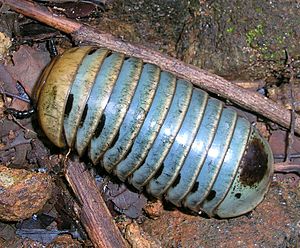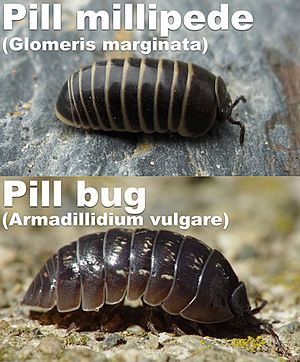Pill millipede facts for kids
Pill millipedes are small creatures that are part of the millipede family. They are often grouped together into a larger group called Oniscomorpha. The name Oniscomorpha sounds a bit like "Oniscidea," which is the scientific name for woodlice, also known as pillbugs or "roly-polies." This is because pill millipedes look a lot like these woodlice.
However, even though they look similar, pill millipedes and woodlice are not closely related. Millipedes belong to a group called Myriapoda, while woodlice are crustaceans. Their similar appearance is an example of convergent evolution. This means they developed similar features independently because they live in similar ways or face similar challenges.
Contents
What are Pill Millipedes Like?
Pill millipedes have shorter bodies than most other millipedes. They usually have only eleven to thirteen body parts. When they feel scared or threatened, they can roll up into a tight ball. This is a clever way to protect themselves from animals that might want to eat them. This ability to roll into a ball actually developed separately in different groups of pill millipedes. This is another cool example of convergent evolution.
Pill millipedes also have another defense trick. They can release a bad-smelling liquid. This liquid can be both irritating and poisonous to predators, helping them get away safely. Pill millipedes are detritivores, which means they eat dead and decaying plant material. You can usually find them in woodlands, helping to clean up the forest floor.
Types of Pill Millipedes
There are two main groups of living pill millipedes, plus one group that is now extinct.
Glomerida: Northern Pill Millipedes
The Glomerida group of pill millipedes mostly lives in the Northern Hemisphere. A well-known species in this group is Glomeris marginata, which is a common pill millipede found in Europe.
These millipedes have eleven to twelve body segments. They have special openings on their backs called ozopores. These openings release the defensive liquid. Glomeridans can grow up to about 20 millimeters (0.8 inches) long. If they have eyes, they are usually in a single row. There are about 450 known species in this group. You can find them in Europe, South-east Asia, and parts of the Americas, from California to Guatemala.
Sphaerotheriida: Southern Pill Millipedes
The Sphaerotheriida group of pill millipedes is found in the Southern Hemisphere. They live in places like southern Africa, Madagascar, Australasia, and South East Asia. For example, there are five species in New Zealand and about thirty species in Australia.
Sphaerotheriidans have thirteen body segments. Unlike Glomeridans, they do not have the special glands that release defensive liquid. These millipedes can grow much larger than Glomeridans, reaching up to 10 centimeters (4 inches) long. They always have large, kidney-shaped eyes.
Amynilyspedida: Extinct Pill Millipedes
There was also an extinct group of pill millipedes called Amynilyspedida. These lived a very long time ago, during the upper Carboniferous period, in North America and Europe.
Amynilyspedida millipedes were different from the other two groups because they had 14 to 15 body segments. One genus in this group, Amynilyspes, had unique spines on its back plates. Other genera included Glomeropsis, Archiscudderia, and Palaeosphaeridium.
See also
 In Spanish: Oniscomorfos para niños
In Spanish: Oniscomorfos para niños



